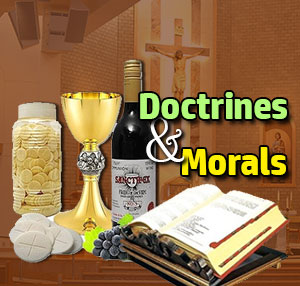STILL ON LITURGICAL MUSIC
Among examples of sacred music are Gregorian chant, sacred polyphony in its various forms both ancient and modern, sacred music for the organ and other approved instruments, and sacred popular music, be it liturgical or simply religious. But while the Gregorian chant remains a musical treasure in Roman Catholicism, we as Catholics are not tied to the Gregorian chant. For there are other Catholic traditions, like the traditions of the eastern rites, that privilege other chants.
There is room for our own African chants in our worship as Catholics. For we do not have to be de-Africanized to be Catholics. We ought to be Catholics as Africans. The Church at the Second Vatican Council, in her openness to non-western cultures, recognized that sacred music should utilise the culture of peoples and take into account abilities of each liturgical assembly. The nature and laws of each language must be respected, and the features and special characteristics of each people must be taken into consideration: all this, together with the laws of sacred music, should be carefully considered by musicians in the preparation of new melodies.
Sacred music should reflect the meaning and proper nature of the part of the liturgy in which it is being rendered. This is done by "using the kind and form of music which is proper to their character." That such use of appropriate music is already in our African traditions is what we find in the different types of music and chants for different occasions and different moods in our African celebrations prior to Africa's encounter with Christianity.
A number of concrete applications of what has been said would be in order. By way of concrete application, it is important to bear in mind the following: first, our choice of songs must adequately reflect the parts of the Mass, the liturgical feast, or the liturgical season. You do not sing an Advent hymn at Easter. Neither do you sing a Lenten hymn in Advent. Liturgical singing is meant to proclaim the word of God at that part of the Mass and during that particular liturgical season. It is therefore important to look at the readings of the Mass and identify the theme(s) that feature in the portion of the word of God chosen for the liturgy before choosing songs.
Secondly, singing is a form of prayer, and what we say in our prayer reflects what we believe. It is therefore important to be vigilant over the words of some of the songs we sing. Some of the songs we hear at Mass today do not reflect Catholic teaching. I have alluded to some of such songs in a previous article on this column.
Thirdly, the rhythm of our music in the liturgy must reflect the mood of the celebration and or the mood of the part of the celebration. It is, for example, awkward to sing and dance joyfully during the penitential parts of the Mass. For if you have offended someone, and you are going to him or her to tender an apology, you do not go singing and dancing. This point calls for a critical look at the way we sing or chant the Kyrie or Agnus Dei, especially in many of our African languages.
Fourthly, the wise counsel of the Second Vatican Council needs to be heeded. According to the Council in Sacrosanctum Concilium, 121. "Composers, filled with the Christian spirit, should feel that their vocation is to cultivate sacred music and increase its store of treasures….Let them produce compositions which have the qualities proper to genuine sacred music, not confining themselves to works which can be sung only by large choirs, but providing also for the needs of small choirs and for the active participation of the entire assembly of the faithful….The texts intended to be sung must always be in conformity with Catholic doctrine; indeed they should be drawn chiefly from holy scripture and from liturgical sources.
Fifthly, one cannot speak of liturgical music without speaking of the role of the choir. On this too, we must learn from Musicam Sacram. The role of the choir is "to ensure the proper performance of the parts which belong to it, according to the different kinds of music sung, and to encourage the active participation of the faithful in the singing" (Musicam Sacram, 19). While there are parts that the choir may perform alone, the choir is not an orchestra performing before a passive audience. It is to lead the assembly to participate in the performance of sacred music, taking care that "the people always associate themselves with the singing by performing at least the easier sections of those parts which belong to them" (Musicam Sacram, 20)
Sixthly, the choir is not just a group of singers and instrumentalists. They must be persons who are themselves formed to play a liturgical function. The choir needs not only musical formation, but also suitable liturgical and spiritual formation, "in such a way that the proper performance of their liturgical role will not only enhance the beauty of the celebration and be an excellent example for the faithful, but will bring spiritual benefit to the choir-members themselves" (Musicam Sacram, 24).
Seventhly, guidelines on the use of musical instruments in the liturgy also deserve our attention. According to Musicam Sacram, "Musical instruments can be very useful in sacred celebrations, whether they accompany the singing or whether they are played as solo instruments" (62). Moreover, "Any musical instrument permitted in divine worship should be used in such a way that it meets the needs of the liturgical celebration and is in the interests both of the beauty of worship and the edification of the faithful" (63). On this score, it is quite regrettable when musical instruments like the drums or the organ crowd out the voices of those in the choir. One gets the impression that some of our drummers get carried away, I do not want to say intoxicated, while drumming. And so, continues Musica Sacram, "The use of musical instruments to accompany the singing can act as a support to the voices, render participation easier, and achieve a deeper union in the assembly. However, their sound should not so overwhelm the voices that it is difficult to make out the text; and when some part is proclaimed aloud by the priest or a minister by virtue of his role, they should be silent" (64). "The playing of these same instruments as solos is not permitted in Advent, Lent, during the Sacred Triduum and in the Offices and Masses of the Dead" (66).
Lastly, the words of the book of Deuteronomy can put things in perspective for us. "Listen, Israel: the Lord our God alone is God. You must love the Lord your God with all your heart, with all your soul, with all your strength…." (Deut 6: 4-5). This admonition helps us to understand the role of liturgical music. Liturgical music is music set aside - sacred music - to worship the Lord our God who alone is God. There is no other God to worship. The confusion between religion and entertainment places a great temptation before us in the liturgy, and that is, to sing and dance to worship our senses and not to worship God. Surely, our bodies and our senses, our emotions and our minds, our whole being, must worship God. It is therefore in order that we sing and dance. But it is out of liturgical order to sing and dance, just to entertain ourselves, just to please the senses, without lifting our whole being to God.
© 2024 - Catholic Archdiocese of Ibadan





